Viewing Orders
The View Orders area is where you will access your orders and view their details. While managing your business, you will work in this portion of the control panel frequently. You will want to become familiar with its features and capabilities, such as viewing order details, accessing order timelines, capturing payments on authorized transactions, creating shipments, and processing refunds. Go to Orders › View in the control panel to manage your orders.
Order Views
The first thing you will notice are the tabs across the top. All Orders is selected by default. They provide a quick and easy way to find orders you are looking for. They filter orders based on a specified order status or condition.
For example, if you only wanted to see newly paid for orders that have yet to be processed, you would switch the view to Awaiting Fulfillment, which indicates the customer has checked out with a successful transaction.
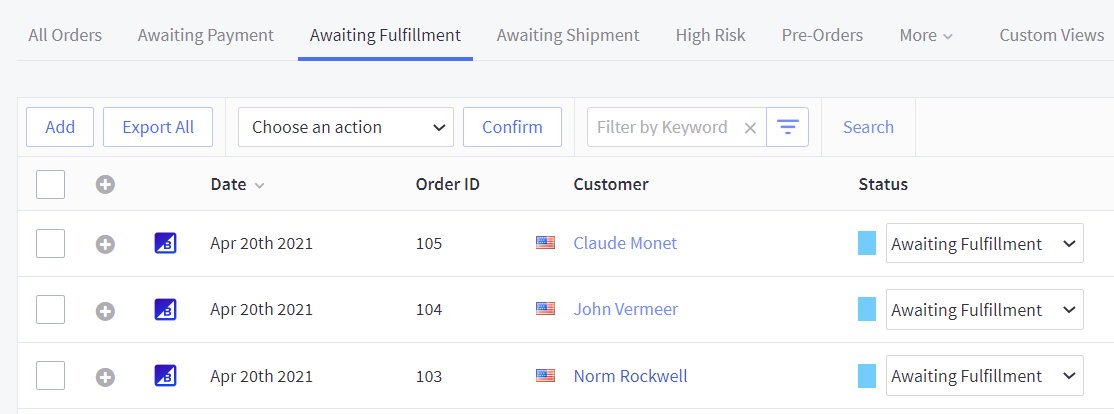
The More tab contains additional views for past or completed orders.
Custom Views
Keeping your orders organized for easier fulfillment is critical to success, especially for stores with large order volume. Custom Views allow you to sort your orders in the following manners:
- Keywords (in billing and shipping details, and Order ID)
- Order Status
- Payment Method
- Channels
- Shipping Method
- Fulfillment Source
- Guests who may be Customers
- Coupon Code
- Pre-Orders
- Deleted Orders
- Order ID Range
- Order Total Range
- Order Date Range
Go to Orders › View and select Custom Views. Click create a new view.
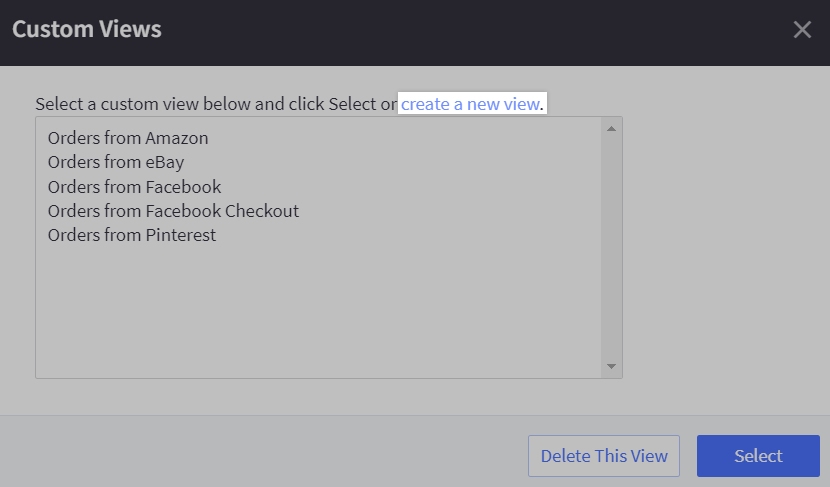
Fill out the form on the following screen to create your new view.
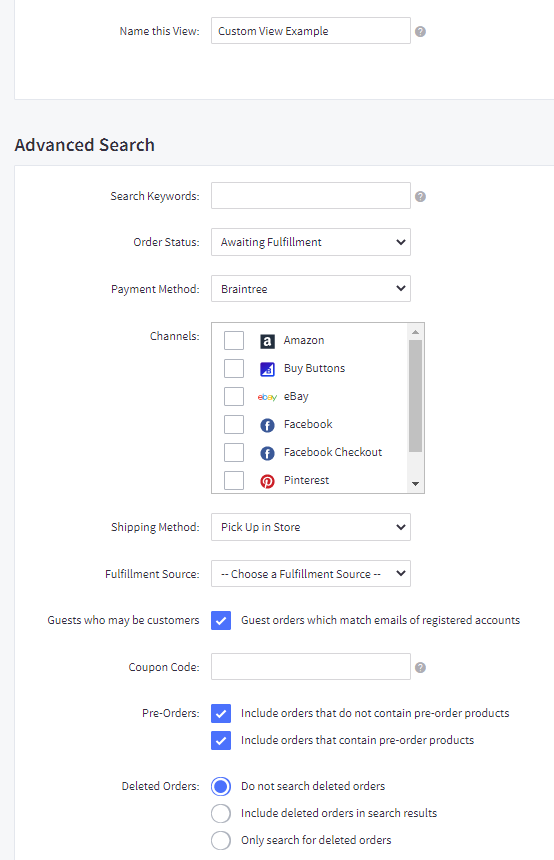
Pro Tip! Bookmark your saved Custom Views in your browser for quick, easy access. Some examples include viewing orders from Facebook, and orders flagged for potential fraud (using the Manual Verification Required order status).
You also have the ability to search your orders with the Filter by Keyword field or by using the Search button.

Order Details
You can view the particulars of any order by clicking the + icon to the left of the order, or you can expand the details for all orders on the page by clicking the + icon located in the menu bar at the top.
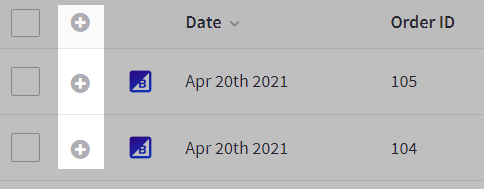
The first column displays the order's billing information, the date/time the order was placed, IP address, order source (such as storefront, manual order, or a channel like Facebook), the type of payment used, payment status, the transaction ID, and the tax method used (basic tax or an automatic tax provider).
The second column shows the order's shipping information, such as the shipping address, shipping zone (as determined from the Shipping page) and method, shipping cost, and the date that the order was shipped, as determined by the Ship Items action. It will also show any custom account fields added to the checkout page. See Adding and Editing Fields in the Account Signup Form for more information.
If the order contains only digital products, the second column will be blank.
The third column features quantities, options, brands, charges, and other details about the items included in the order.

Certain payment gateways will create a clickable transaction ID for the order that will take you to your payment provider's dashboard. This allows for quick reconciliations by viewing the settled funds associated with your transactions against the payment receipts from your payment provider.
These payment gateways will create clickable transaction IDs for orders:
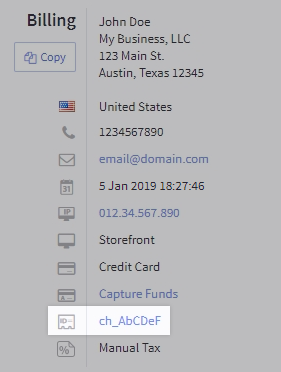
The customer's IP address is logged to determine where the order originated geographically. If an order's billing address does not match, the order is flagged as possibly fraudulent.

The source of the order is represented by an icon to the left of each entry. If you hover over these icons, you will see labels like Storefront, Instagram, Mobile Device, Manual Order, or even Checkout API. A manual order means you created the order within your control panel. A checkout API order means that the order was created using the Checkout API, not the checkout flow on the storefront or via control panel. See the Dev Center to learn more about our cart and checkout documentation.
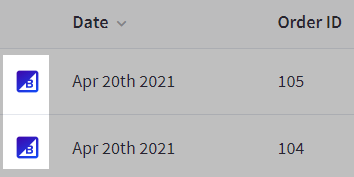
To the far right of each order, you will find Actions that allow you to manipulate orders.
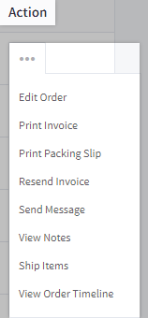
You can see the customer group of an order by performing an order export with a custom export template. This information is useful for determining the percentage of orders coming from a particular group. Enable the Customer Group Name field under the Orders tab while editing your custom export template to display this information in your CSV orders reports.
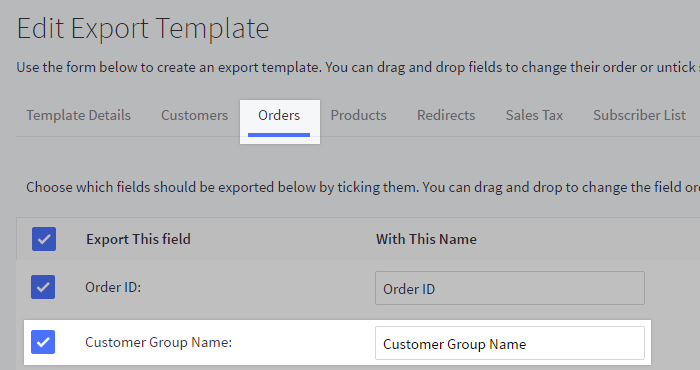
Changing Orders in Bulk
In addition to the action button, there is also a “Choose an action” dropdown menu at the top of the order table. It allows you to apply certain actions in bulk to multiple orders, including some not available via the action button, like:
- capture funds for selected
- export selected
- archive selected
To apply an order status or perform an action in bulk, check the box to the left of each desired order, then select an action from the Choose an Action drop-down and click Confirm.

Pro Tip! Cancelling and archiving an order will prevent its value from being included in analytical reporting. This gives you the ability to perform some test orders without affecting your reporting data. As volume increases, archiving also becomes a useful tool for keeping your order area tidy. The status of an archived order cannot be changed, but they can be un-archived, if necessary. Archived orders cannot be viewed by customers in their storefront account.
Viewing Orders with Specific Products
Sometimes you may want to locate which orders contain a specific product. This can be helpful when researching upcoming sales or promotions. You can find them in the Products portion of your control panel by going to Products › View. Locate the product you wish to research and click on Action › View Orders.
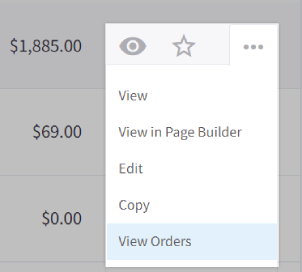
You'll be taken to the View Orders page where you'll see only the orders containing that specific product. From here, you can view the order details or export the orders by selecting Export All.
Searching Orders
You can search your orders by going to Orders › View and entering your query, such as an order ID, product SKU or customer name, in the Filter by Keyword field, then clicking the filter icon. For more advanced search queries that let you search by a range of criteria, click the Search button or go to Orders › Search.

Planning to search for the same criteria more than once? Consider making a custom view, so that you do not need to perform the same search multiple times.
Advanced Search
For more detailed order searches, go to Orders › Search. The Advanced Search allows you to search orders by the following criteria:
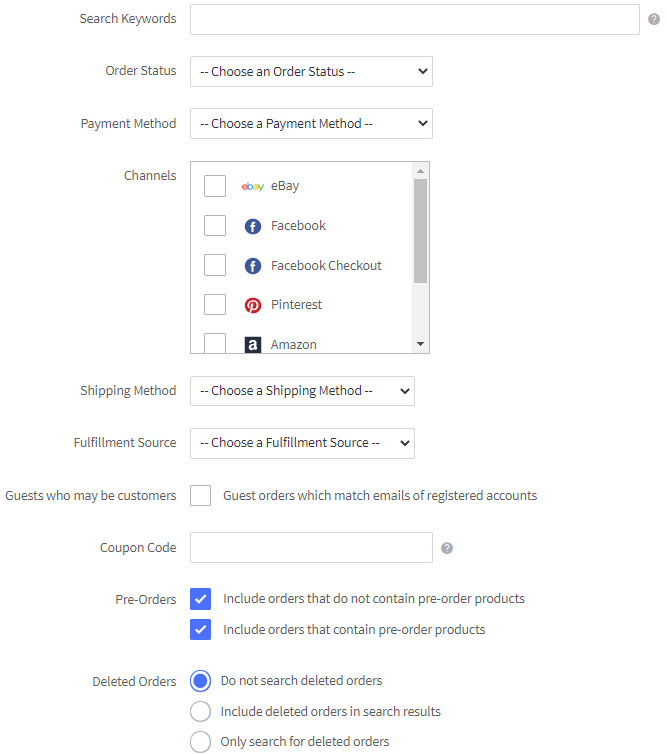
- Search Keywords — the keywords you type into this box will be used to search the order ID (including IDs assigned by external sources), billing details, and shipping details
- Order Status — allows you to narrow your search to a particular order status
- Payment Method — allows you to narrow your search to a particular payment method you have setup in your control panel's payments area
- Channel — allows you to narrow your search by what channel the order originated from. For example, if you are integrated with Amazon, you can narrow the search to only Amazon orders or only BigCommerce orders.
- Shipping Method — allows you to narrow your search to those orders that used a particular shipping type, such as FedEx, UPS, and ShipperHQ. You can also filter by Flat Rate/Ship by methods.
- Fulfillment Source — this field is deprecated
- Guests who may be customers — filters guest orders which match the emails of registered accounts, allowing you to link guest orders to existing customer accounts
- Coupon Code — enter a coupon code in this box to view all orders that applied that particular coupon. Only complete coupon codes can be searched. Serialized coupons that may share a common prefix or suffix cannot be searched by just their shared elements.
- Pre-Orders — specify whether or not to include pre-order items in your search, or even narrow to only products with pre-order availability
- Deleted Orders — determine whether or not to include deleted orders in your search, or to only search deleted orders
Search by Range
The settings in Search by Range allow you to search orders by the following criteria:
- Order ID — specify a range of Order IDs to search from
- Order Total — specify a range of order totals to search from
Search by Date
The settings in Search by Date allow you to search orders by the following criteria:
- Date Range — allows you to narrow your search results using a specific preset date range, or define a custom date range by selecting Custom Period
- Date Type — specify if the selected Date Range applies to the date the order was placed, the “delivery/event date” specified on a product or both
FAQ
Can orders be deleted?
Orders cannot be deleted, but they can be archived, which removes them from the order list and analytics. Orders can be archived through the control panel and via the Orders API.
How can I narrow down my search results when I'm using keywords to search orders?
To narrow down your search results within a single field (such as billing details, shipping details, or order ID), try putting the specific keywords in quotes.
How do I locate externally-placed orders in the control panel?
If an order was placed from a sales channel like Amazon or Facebook Shop, or via the Orders API, it will be assigned an external ID. This can be seen in the External Order Id field of the order’s details.
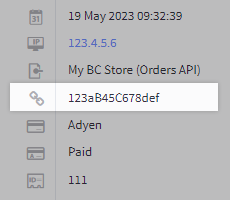
You can locate an order by entering its external ID in the Advanced Search, or in the universal search bar at the top of the control panel.
Is it possible to search for orders from a specific state/province or country?
Yes, you use the state/province or country name as a keyword to bring up orders in that region. For the most accurate results, enter the spelled out name in the Filter by Keyword field.
How do orders with an in-store pickup method appear in the control panel?
If an order was placed using a pickup method configured with Buy Online, Pick up in Store APIs, the Shipping column is changed to Pickup, and displays the pickup location and method that was selected instead of a shipping address. Additionally, the Ship Items action is replaced with Ready for Pickup, which allows you to notify the customer when and how they can retrieve their items.
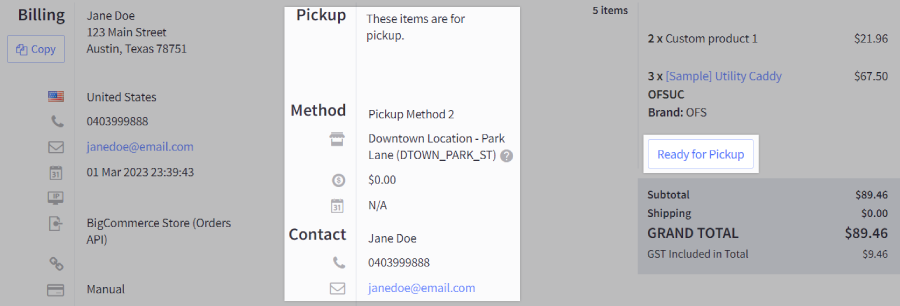
 © Copyright 2003 - 2024 BigCommerce Pty. Ltd. Shopping Cart Software
© Copyright 2003 - 2024 BigCommerce Pty. Ltd. Shopping Cart Software